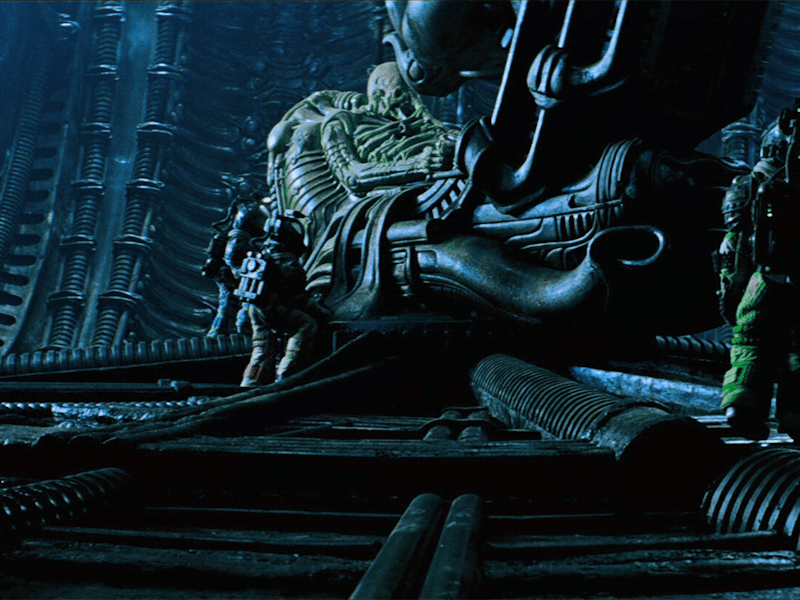The Horror Classic That Inspired Alien Is Still Terrifying Today
And available now as an incredible Blu-ray collector’s item.

Under the sweltering sun, a green van rumbles down lonely Texan roads. Blanketed by darkness, a spaceship drifts through the oppressive silence of outer space. Released five years before Alien (1979), Tobe Hooper’s nightmarish vision of American depravity and destruction illustrated how rural America could be just as unknowable and terrifying as a planetoid in the furthest reaches of the cosmos, its inhabitants as strange, unsettling and alien as a Xenomorph.
The Texas Chain Saw Massacre was banned in several countries, but its gruesome sights and sounds seeped through the collective imagination. It left a lasting impression on director Ridley Scott, who cited it as an inspiration for Alien.
“It was horrendous, and it scared the shit out of me,” he told The Hollywood Reporter in 2019. “I think I started with a hamburger at lunchtime and never took a bite… It was my challenge to say: How do I get that scary?”
Dark Sky’s 50th Anniversary Chainsaw Edition of The Texas Chain Saw Massacre is available now and includes 4k UHD, Blu-ray, and VHS versions of the horror classic.
Horrors both visual and aural instill a deep sense of unease right from the first frames of The Texas Chain Saw Massacre. The flash of a camera illuminates the screen only for a few seconds at a stretch, revealing the gnarled flesh of corpses in rigor mortis. Accompanying the whir of the shutter are the metallic sounds of digging and scraping. By the time Sally Hardesty (Marilyn Burns) and her friends pull into town, a shot of roadkill and reports of death and violence on the radio have all but confirmed what their grisly fate will be. Like the crew of the Nostromo, they’ve ventured into unfamiliar territory, only to be hit with the sickening revelation that any hope of escape is futile.
Just as a facehugger attaches itself to Alien’s Kane (John Hurt) who then brings it aboard, Sally and her friends too find themselves in the company of an unnerving hitchhiker (Edwin Neal), one who terrorizes the group, first with graphic photos of slaughtered animals, and then by drawing blood of his own. The Texas Chain Saw Massacre repeatedly highlights the fragility of the flesh, contrasting Pam’s (Terri McMinn) long, tanned limbs and the expanse of her back in a halter top against the heaps of human bones strewn around the workshop where she is eventually killed. If Alien’s extraterrestrial species view the human body as incubators for their offspring, the cannibalistic predators in The Texas Chain Saw Massacre see it as a fresh source of meat.
Like a sledgehammer to the skull, its shattering impact is undeniable.
Both groups are utterly ill-equipped to defend themselves against their attackers, but unlike the Xenomorph, the chainsaw-wielding Leatherface (Gunnar Hansen) is far from the “perfect organism.” He doesn’t bleed corrosive acid. He doesn’t trick or stalk his prey, but lumbers towards them in plain sight. And despite the guttural, animalistic sounds that emerge from him, he’s a flesh-and-blood human being just like Sally and her friends. His utter ordinariness is what makes him even more frightening. As he gets to work after impaling Pam on a meat hook, the film cuts to a windmill turning serenely outside. It’s just another day in rural America, pockets of evil concealed everywhere within the fabric of this country. In the same way, it’s Grandfather’s (John Dugan) advanced age (he’s so feeble that when the family goads him into bludgeoning Sally, the hammer only drops limply from his hand over and over and over again) that lets the film draw out the dread.
The most obvious similarity The Texas Chain Saw Massacre and Alien share, however, is their examination of corporate and capitalistic cruelties. In Alien, the path to scientific advancement is paved with human bodies, the Nostromo’s crew expendable if it means the Weyland-Yutani corportation can capture an alien for research. Leatherface’s family turns to cannibalism after automatization renders their slaughterhouse jobs obsolete. “My family’s always been in meat,” says the hitchhiker, leaving unsaid the kind of animal they’ve switched to dismembering. As Sally and her friends drive past the slaughterhouse, they’re lambs being led to the slaughter themselves.
Leatherface’s family turns to cannibalism after automatization renders their slaughterhouse jobs obsolete
The Texas Chain Saw Massacre also captures the feeling of utter abandonment, the sinking realization that there is no one coming to save you. Hooper cuts between Sally frantically running through Leatherface’s house in search of help and him hacking through the front door. As she pleads with an unresponsive grandfather, the revving of the chainsaw draws closer, her window of hope snapping shut. When she later seeks refuge with what she — and the audience — assumes is a kindly gas station proprietor (Jim Siedow), lingering shots of meat roasting on a spit foreshadow what he intends to do to her. Similarly, Alien also features a man the characters trust to help extricate them from the trap they’ve found themselves in, only to realize he’s actually been nudging them towards it the whole time. Science officer Ash (Ian Holm) isn’t a man at all, but revealed to be a Weyland-Yutani android deployed to ensure the mission’s success.
Sally may have escaped Leatherface’s grasp, but his stranglehold on popular culture remains. Fifty years later, it continues to spawn sequels and inspire directors such as Wes Craven and Alexandre Aja. Like a sledgehammer to the skull, its shattering impact is undeniable.